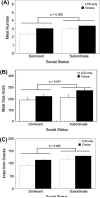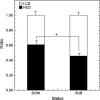Small changes in meal patterns lead to significant changes in total caloric intake. Effects of diet and social status on food intake in female rhesus monkeys
- PMID: 23207191
- PMCID: PMC4920003
- DOI: 10.1016/j.appet.2012.11.011
Small changes in meal patterns lead to significant changes in total caloric intake. Effects of diet and social status on food intake in female rhesus monkeys
Abstract
Social subordination in macaques is a well-established model to study the adverse effects of psychosocial stress on a number of health outcomes, including stress-induced eating. The present analysis was conducted to empirically define a meal among free-feeding female rhesus monkeys and to examine the roles of meal patterning (e.g., meal size, meal frequency, and snacking patterns) in findings from a previous study demonstrating that psychosocial stress increases overall caloric intake among subordinate animals with access to a highly palatable diet. Results indicate that all animals, regardless of social status, consumed more frequent meals, larger meals, and more calories in the form of snacks when a highly palatable diet was available. Additional findings suggest that subordinate animals consumed significantly larger meals compared to their dominant counterparts regardless of the dietary environment. Additionally, subordinate females with a history of exposure to the palatable diet consumed significantly more snack calories than both dominant and subordinate animals without previous exposure to the palatable diet when these females were returned to a standard laboratory diet. These findings illustrate how small changes in meal patterns can lead to significant increases in total caloric intake, which if prolonged, could promote the emergence of an obese phenotype.
Copyright © 2012 Elsevier Ltd. All rights reserved.
Figures







References
-
- Abbott DH, Keverne EB, Bercovitch FB, Shively CA, Mendoza SP, Saltzman W, et al. Are subordinates always stressed? A comparative analysis of rank differences in cortisol levels among primates. Hormones and Behavior. 2003;43(1):67–82. - PubMed
-
- Adam TC, Epel ES. Stress, eating and the reward system. Physiology & Behavior. 2007;91(4):449–458. doi: S0031-9384(07)00127-8 [pii] 10.1016/j.physbeh.2007.04.011. - PubMed
-
- Adams CE, Morgan KJ. Periodicity of eating. Implications for human food consumption. Nutrition Research. 1981;1:26.
-
- Araujo JA, Milgram NW. A novel cognitive palatability assessment protocol for dogs. [Research Support, Non-U.S. Gov't]. Journal of Animal Science. 2004;82(7):2200–2206. - PubMed
-
- Asarian L, Geary N. Modulation of appetite by gonadal steroid hormones. [Research Support, N.I.H., Extramural Research Support, Non-U.S. Gov't Review]. Philosophical Transactions of the Royal Society of London. Series B, Biological Sciences. 2006;361(1471):1251–1263. http://dx.doi.org/10.1098/rstb.2006.1860. - DOI - PMC - PubMed
Publication types
MeSH terms
Grants and funding
LinkOut - more resources
Full Text Sources
Other Literature Sources
Medical

